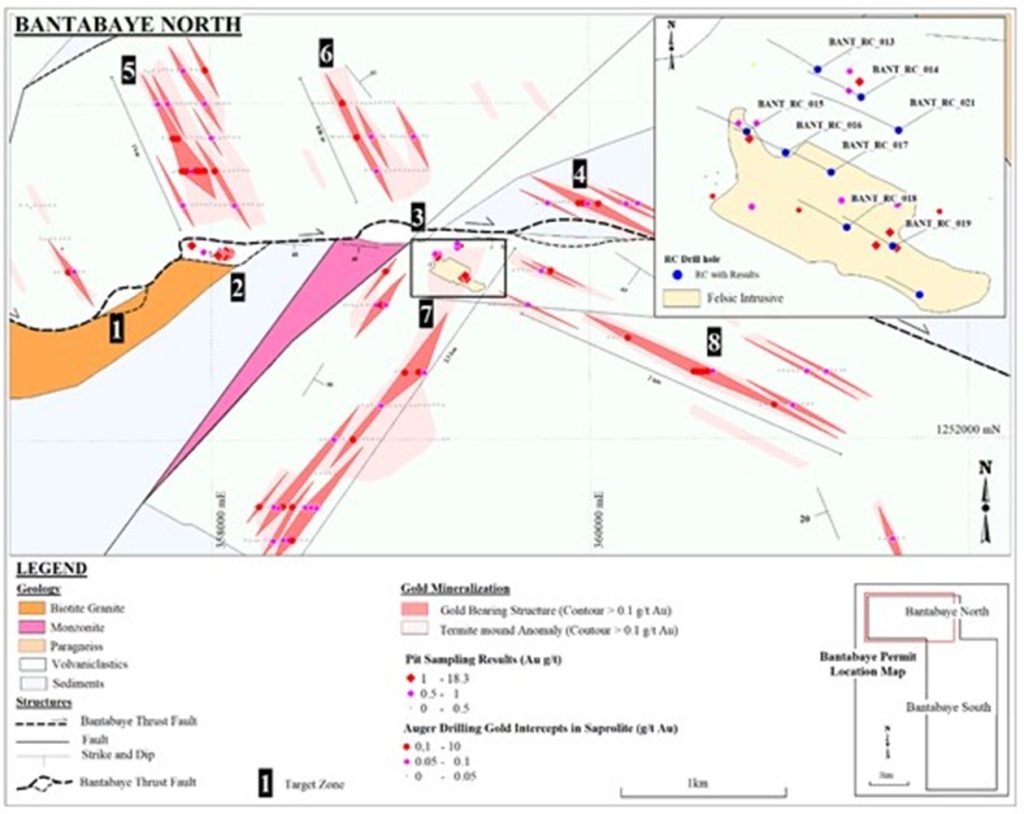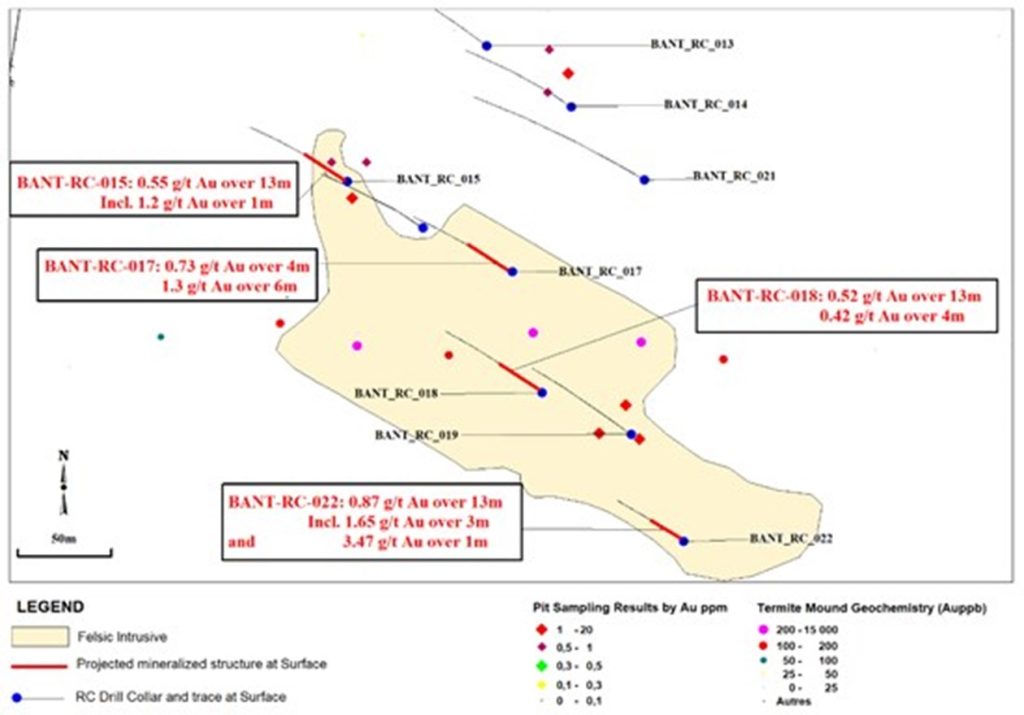
Sanu Gold Continues to Intersect Gold Mineralization at Multiple Targets on the Bantabaye Permit in Guinea, West Africa
Sanu Gold Corporation (CSE: SANU) (OTCQB: SNGCF) is pleased to announce additional gold intercepts from multiple target areas on the Bantabaye gold exploration permit in Guinea, West Africa. The Permit, which lies on the western margin of Guinea’s prolific Siguiri Basin, is located approximately 50 kilometres south of the multi-million once Lefa Gold Mine and 80 km north of the multi-million ounce Bankan Gold Project.
The Company has received the results from a further 19 drill holes from its inaugural reverse circulation drill program at Bantabaye, targeting extensive and continuous zones of gold in bedrock anomalies.
Highlights include:
- 1.44 g/t Au over 13 m at Target 3 (BANT-RC-009)1,
- 0.90 g/t Au over 17 m at Target 2 (BANT-RC-006), and
- 0.87 g/t Au over 13 m, as well as 3.47 g/t Au over 1 m further downhole at Target 7 (BANT-RC-022).
Martin Pawlitschek, President and CEO, commented: “It is extremely positive to see that we have intersected significant zones of gold mineralization on three main targets at Bantabaye. Gold mineralization at these targets occurs along a 6 kilometre long segment of the Bantabaye Thrust Fault, interpreted to be a key feature in this large, structurally hosted gold-bearing system. Importantly, we are also seeing similarities between gold mineralization at Bantabaye and other recent discoveries in the Siguiri Basin.”
“These targets are now confirmed as hosting significant widths and grades of gold mineralization. They are open in all directions and will require systematic follow-up drilling,” continued Mr. Pawlitschek.
Program Details
The inaugural RC drill program at Bantabaye commenced in early April, 2023. To date, the Company has drilled 2,475 m in 22 RC holes on Targets 2, 3, 4 and 7. This program was designed to provide an initial drill test below high grade gold in rock chip samples from artisanal working pits at high-priority targets.
As reported in the Sanu Gold news release dated May 17, 2023, results from the first three holes of the program from Target 2 included:
- 11.4 g/t Au over 15 m, including 41.2 g/t Au over 4 m in BANT-RC-002, and
- 2.0 g/t Au over 12 m, including 6.8 g/t Au over 1 m and 5.0 g/t Au over 1 m in BANT-RC-003.
Target 2
A total of 626 m in six RC holes has been completed to date on two 50 m spaced lines at Target 2, with the objective of testing the downdip extension of high grade gold in rock chip samples collected from artisanal workings (Figures 1 and 2 and Table 1). Gold mineralization at this target is associated with a strongly silicified and hydrothermally altered felsic intrusive at the sheared contact with a foliated mafic unit. The altered felsic intrusive contains quartz vein stockwork and breccia and pervasive disseminated pyrite and arsenopyrite. Key alteration associated with the gold mineralization is silicification and associated disseminated pyrite and arsenopyrite. Gold mineralization at Target 2 is hosted in oxidized rock at surface and in near-surface intercepts, and in unoxidized rock in the deeper holes drilled to date. Oxidation extends to a vertical depth of approximately 25 m in this area of the Permit.
Drilling has delineated a gold mineralized structure at Target 2, with assays from the first three RC holes on the eastern line returning high-grade gold intercepts of 11.4 g/t Au over 15 m in BANT-RC-002 and 2.0 g/t Au over 12 m in BANT-RC-003 (see Sanu News Release dated May 17, 2023, Table 1, Figure 2: Section 1).
Both the felsic intrusive and mafic unit, as well as the higher grade mineralization below the sheared felsic intrusive contact, are extensively mined by artisanal workers. On the western line targeted by RC holes BANT-RC-005 and BANT-RC-006 the higher grade gold mineralization appears to have been mined out, with assays reported herein of 0.90 g/t Au over 17 m, including 2.57 g/t Au over 2 m and 2.78 g/t Au over 1 m in BANT-RC-006 (Table 1, Figure 2: Section 2).
Interpretation of the geology, alteration, structure and mineralization at Target 2 demonstrates that the mineralized structure strikes east-southeast and dips moderately to the south-southwest. The mineralization is open down dip and in both directions along strike. Additional drilling is planned to continue to test size and tenor of this new discovery.
Target 3
A total of 749 m in six RC holes has been completed to date at Target 3 to test the shallowly south dipping, east-southeast striking Bantabaye Thrust Fault along a 300 m long by 150 m wide zone of artisanal workings.
Gold mineralization is associated with a strongly silicified and hydrothermally altered felsic intrusive at the sheared contact between the volcaniclastic sequence on the footwall side of the Bantabaye Thrust Fault and the sedimentary unit in the hanging wall. Geological and structural interpretations from field mapping demonstrate that the shear zone that controls the gold mineralization strikes northwest and is shallowly southeast dipping (Figures 3 and 4). Gold mineralization is associated with quartz vein stockwork and breccia, as well as boxwork after sulfide within the felsic rock. Drilling revealed that Target 3 is situated within an area of deep oxidation, with saprolite extending up to 150 m vertical depth, suggesting intensive deep fracturing and hydrothermal alteration during deformation, following by deep weathering of the rocks. Interpretation of the geological cross section and structural measurements from field mapping indicates that gold mineralization is open along strike toward the northeast.
Drill hole BANT-RC-009 returned 1.44 g/t Au over 13 m, including 5.10 g/t Au over 1 m and 4.91 g/t over 1 m (Table 1, Figures 3 and 4). The remaining five holes appear to have been collared too far north to test the mineralized structure.
Figure 1: Bantabaye North maps showing Target 2 RC drill holes.
Target 7
Three fences of three holes each were drilled at Target 7, for a total of 1,000 m in nine RC holes to test high grade gold in rock chip samples from artisanal workings over a 400 m long by 150 m wide area associated with strong gold in termite mound anomalies. Highlights from initial Target 7 drilling include:
- 0.87 g/t Au over 13 m, including 1.65 g/t over 3 m and further downhole 3.47 g/t Au over 13 m in BANT-RC-022,
- 0.55 g/t Au over 13 m, including. 1.2 g/t Au over 1 m in BANT-RC-015,
- 0.52 g/t Au over 13 m and further downhole 0.42 g/t Au over 4 m in BANT-RC-018, and
- 0.73 g/t Au over 4 m, and further downhole 1.03 g/t Au over 6 m in BANT-RC-017.
Initial drill holes targeted the north-northeast trend observed from the extensive gold in termite mound anomalies at Target 7 supported by north-northeast trending lines of artisanal shafts and some structural measurements. Updated detailed geological and structural mapping of outcrops and artisanal workings and results from the RC drilling demonstrate that the gold mineralization is associated with northeast striking and shallowly southwest dipping felsic intrusive rock that extends for over 500 m along strike and 150 m in width. At surface, the felsic intrusive is extensively altered and sheared with local stockwork of quartz veinlets, breccia development and boxwork after sulphide minerals. These zones of strong alteration are extensively mined by artisanal miners and deeply weathered to at least 100 m.
Figure 2: Target 2 cross-sections 1 and 2, showing geology and structural interpretation, location of artisanal workings, RC drill hole traces and highlighted assays results from RC drill holes BANT-RC-001 to -006).
Figure 3: Bantabaye North maps showing Target 3 RC drill holes.
Figure 4: Target 3 cross-section showing geology and structural interpretation, location of artisanal workings, RC drill hole traces and highlighted assays results from RC drill holes BANT-RC-007 to -009.
Figure 5: Bantabaye North maps showing Target 7 RC drill holes.
Figure 6: Bantabaye North maps showing Target 7 RC drill holes and gold intercepts.
Table 1: Bantabaye Target 2, 3, 4 and 7 RC drill hole drill intercepts.
| Hole ID | X-UTM | Y-UTM | Intercept | Interval | From | Target | |||
| Length | Azimuth | Dip | |||||||
| (m) | (o) | (o) | (g/t Au) | (m) | (m) | ||||
| BANT-RC-001 | 358,08 | 1,253,118 | 56 | 30 | -60 | 0.8 | 4 | 12 | Target 2 |
| including | 1.4 | 1 | 13 | ||||||
| & | 1.3 | 1 | 15 | ||||||
| BANT-RC-002 | 358,068 | 1,253,066 | 90 | 30 | -60 | 11.4 | 15 | 35 | Target 2 |
| including | 41.2 | 4 | 36 | ||||||
| including | 114 | 1 | 38 | ||||||
| & | 0.5 | 12 | 56 | ||||||
| including | 1.6 | 1 | 56 | ||||||
| BANT-RC-003 | 358,039 | 1,253,018 | 150 | 30 | -60 | 2.0 | 12 | 83 | Target 2 |
| including | 6.8 | 1 | 83 | ||||||
| & | 5.0 | 1 | 94 | ||||||
| & | 0.7 | 1 | 104 | ||||||
| BANT-RC-004 | 358 039 | 1 253 018 | 150 | 030 | -60 | NSV | Target 2 | ||
| BANT-RC-005 | 358 018 | 1 253 099 | 100 | 030 | -60 | 0.7 | 3 | 11 | Target 2 |
| including | 1.26 | 1 | 11 | ||||||
| BANT-RC-006 | 357 988 | 1 253 048 | 150 | 030 | -60 | 0.56 | 2 | 56 | Target 2 |
| 0.90 | 17 | 63 | |||||||
| including | 2.57 | 2 | 64 | ||||||
| & | 2.78 | 1 | 72 | ||||||
| BANT-RC-007 | 358 972 | 1 253 256 | 105 | 010 | -60 | NSV | Target 3 | ||
| BANT-RC-008 | 358 970 | 1 253 211 | 106 | 010 | -60 | NSV | Target 3 | ||
| BANT-RC-009 | 358 970 | 1 253 211 | 106 | 010 | -60 | 1.44 | 13 | 23 | Target 3 |
| including | 5.10 | 1 | 28 | ||||||
| & | 4.90 | 1 | 32 | ||||||
| BANT-RC-010 | 359 024 | 1 253 244 | 106 | 010 | -60 | NSV | Target 3 | ||
| BANT-RC-011 | 359 015 | 1 253 192 | 116 | 010 | -60 | NSV | Target 3 | ||
| BANT-RC-012 | 359 013 | 1 253 141 | 165 | 010 | -60 | NSV | Target 3 | ||
| BANT-RC-020 | 359 874 | 1 253 165 | 100 | 300 | -55 | 0.30 | 1 | 1 | Target 4 |
| BANT-RC-013 | 359 270 | 1 253 165 | 110 | 300 | -55 | NSV | Target 7 | ||
| BANT-RC-014 | 359 316 | 1 253 132 | 131 | 300 | -55 | NSV | Target 7 | ||
| BANT-RC-015 | 359 196 | 1 253 092 | 105 | 300 | -55 | 0.55 | 13 | 2 | Target 7 |
| including | 1.20 | 1 | 12 | ||||||
| BANT-RC-016 | 359 236 | 1 253 067 | 100 | 300 | -55 | NSV | Target 7 | ||
| BANT-RC-017 | 359 284 | 1 253 044 | 101 | 300 | -55 | 0.73 | 4 | 1 | Target 7 |
| 1.3 | 6 | 6 | |||||||
| BANT-RC-018 | 359 300 | 1 252 979 | 106 | 300 | -55 | 0.52 | 13 | 1 | Target 7 |
| 0.42 | 4 | 22 | |||||||
| BANT-RC-019 | 359 348 | 1 252 957 | 105 | 300 | -55 | NSV | Target 7 | ||
| BANT-RC-021 | 359 355 | 1 253 093 | 171 | 300 | -55 | NSV | Target 7 Target 7 | ||
| BANT-RC-022 | 359 376 | 1 252 899 | 71 | 300 | -55 | 0.87 | 13 | 1 | Target 7 |
| including | 1.65 | 3 | 6 | ||||||
| 3.47 | 1 | 56 | |||||||
Notes: The Company does not have sufficient information to make a determination of the true widths of the drill hole intersections reported in this release. Drillhole intercepts are calculated using a minimum downhole length of ≥1 m, a cut-off grade of 0.3 g/t gold, and may include up to 3 m of internal dilution within the intercept. Only intercepts ≥1 m are reported. Sample intervals are comprised of RC drill chips, which are sampled at regular 1 m intervals. Assays are reported uncut. Grid coordinates are UTM WGS84 Zone 29N. NSV = no significant values. Results for holes BANT-RC-001 to BANT-RC-003 previously released (see Sanu Gold news release dated May 17, 2023).
Target 4
One RC hole with a length of 100 m has been drilled at Target 4 to begin to test a strong gold in termite mound anomaly along the Bantabaye Thrust Fault. RC drill hole BANT-RC-020 returned 0.3 g/t Au over 1 m.
Quality Assurance / Quality Control
Sampling was completed following industry best practices, conducted under the supervision of the Company’s project geologists and the chain of custody from the project to the sample preparation facility was continuously monitored. An appropriate number and type of certified reference materials (standards) and blanks totaling 5% of the total number of samples shipped to the laboratory was inserted approximately every 20th sample to ensure an effective QA/QC program was carried out. Data verification of the analytical results included a statistical analysis of the standards and blanks that must pass certain parameters for acceptance to ensure accurate and verifiable results. Samples from Target 2 were analyzed using ”Fire Assay FA450” at the Bureau Veritas Mineral Laboratories in Bamako, Mali (“BVML”). BVML is an internationally recognized and commercially certified laboratory and is independent of Sanu Gold. Samples From Targets 3, 4 and 7 were analyzed using Fire Assay FAA505 at the SGS Laboratory in Bamako, Mali (“SGS”). SGS is an internationally recognized and commercially certified laboratory and is independent of Sanu Gold.
Qualified Person
The scientific and technical information contained in this press release has been reviewed and approved by Serigne Dieng, Ph.D., M.Sc., a Member (MAIG) of the Australian Institute of Geoscientists (AIG), Exploration Manager of the Company and a qualified person within the meaning of National Instrument 43-101 – Standards of Disclosure for Mineral Projects.
About Sanu Gold
Located within Guinea’s Siguiri Basin, a world class gold district that is host to several operating mines and major new discoveries, Sanu Gold is exploring three high quality gold exploration permits. The Company is targeting multi-million ounce gold deposits and has discovered high grade gold mineralization in the inaugural drill programs at both Bantabaye and Daina. Sanu is operated by a highly experienced team, with successful records of discovery, resource development and mine permitting in West Africa.
MORE or "UNCATEGORIZED"
Koryx Copper Announces Further Positive Drill Results at the Haib Copper Project, Southern Namibia
Highlights Assays reported for a further 9 drill holes for 4,007m... READ MORE
Cerro de Pasco Resources Inc. Announces Execution of Settlement Agreement with Trevali Monitor
Cerro de Pasco Resources Inc. announces that it has entered into ... READ MORE
Gold Royalty Completes Pedra Branca Royalty Acquisition
Gold Royalty Corp. (NYSE: GROY) is pleased to announce that, furt... READ MORE
Fireweed Intersects Zinc Mineralization at Gayna
Fireweed Metals Corp. (TSX-V: FWZ) (OTCQX: FWEDF) is pleased to r... READ MORE
Brixton Metals Closes Tranche 2 Of Its Private Placement
Brixton Metals Corporation (TSX-V: BBB, OTCQB: BBBXF) is pleased ... READ MORE



















